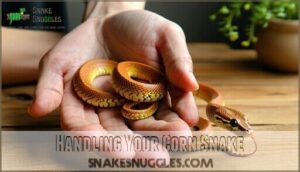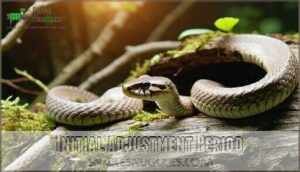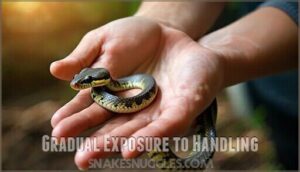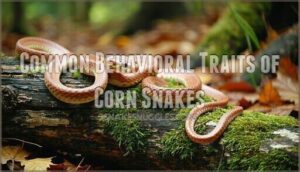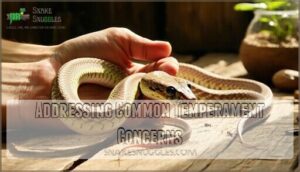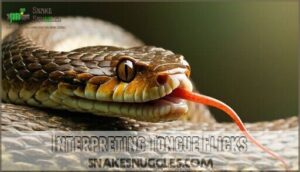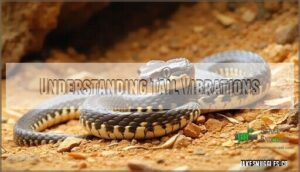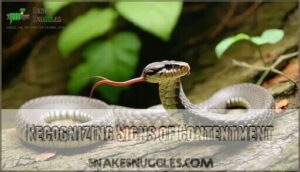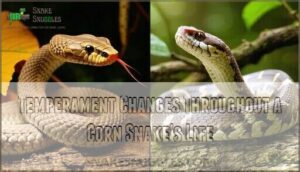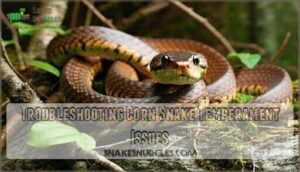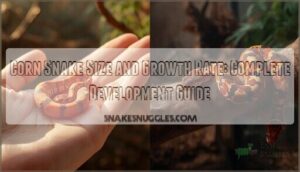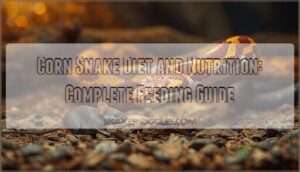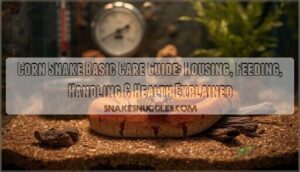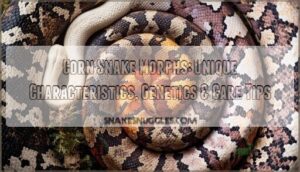This site is supported by our readers. We may earn a commission, at no cost to you, if you purchase through links.
 Corn snake temperament is naturally docile and calm, making these reptiles excellent beginner pets.
Corn snake temperament is naturally docile and calm, making these reptiles excellent beginner pets.
You’ll find they’re curious explorers who rarely bite and handle stress well when their needs are met.
Their gentle nature stems from being non-venomous constrictors that prefer flight over fight.
In captivity, they adapt quickly to regular handling when you approach slowly and support their body properly.
Most corn snakes become comfortable with human interaction within weeks, showing their naturally trusting disposition.
They’re predictable creatures – basking during the day, exploring at dusk, and showing consistent feeding responses.
Their even-tempered personality makes them suitable for families with children over eight years old.
Understanding their body language reveals just how communicative these seemingly quiet creatures can be, and they are excellent beginner pets with a naturally trusting nature that is predictable and gentle.
Table Of Contents
- Key Takeaways
- Corn Snake Temperament Overview
- Handling Your Corn Snake
- Acclimating Your Corn Snake to Human Contact
- Common Behavioral Traits of Corn Snakes
- Corn Snakes as Family Pets
- Addressing Common Temperament Concerns
- Corn Snake Body Language and Communication
- Environmental Factors Affecting Corn Snake Mood
- Temperament Changes Throughout a Corn Snake’s Life
- Troubleshooting Corn Snake Temperament Issues
- Frequently Asked Questions (FAQs)
- Are corn snakes friendly?
- Do corn snakes bond with humans?
- What is the biggest trouble with corn snakes as pets?
- Do corn snakes like being petted?
- Are corn snakes child-friendly?
- What should you know before buying a corn snake?
- Are corn snakes aggressive?
- Do corn snakes show affection?
- Do corn snakes like to be handled?
- How friendly are corn snakes?
- Conclusion
Key Takeaways
- You’ll find corn snakes naturally docile and calm, making them excellent beginner pets that rarely bite and handle stress well when their basic needs are met.
- Your corn snake will become comfortable with regular handling within weeks, showing their trusting nature through relaxed body language and cooperative behavior during interaction sessions.
- You can expect predictable, gentle behavior as corn snakes prefer flight over fight, adapting quickly to captivity while maintaining consistent feeding responses and exploration patterns.
- Your family will benefit from their child-friendly temperament, as corn snakes are suitable for children over eight with proper supervision and show remarkable patience during handling.
Corn Snake Temperament Overview
When you bring home a corn snake, you’ll notice they’re known for being calm, curious, and easy to handle.
Their gentle nature makes them a favorite for both new and experienced snake owners.
Natural Behavior in The Wild
Ever wondered how corn snakes act in the wild? Out in North America, these snakes show off some clever moves.
Here’s what you’ll notice:
- Climbing Behavior: They scale trees and bushes with ease.
- Hunting Strategies: Quick and quiet, they hunt mice, bird eggs, and more.
- Camouflage Use: Their patterned skin blends perfectly into snake habitats.
- Diet Diversity: They’re not picky eaters—variety is key.
- Basking Habits: You’ll catch them soaking up sun on warm rocks.
Typical Temperament in Captivity
Your corn snake’s docile nature really shines in captivity.
Most captive corn snakes develop excellent handling tolerance, becoming calm and cooperative pets.
You’ll notice captive quirks like climbing for attention or relaxing in your sleeve.
While personality variations exist between individual snakes, the taming process typically transforms even skittish hatchlings into trusting companions through consistent, gentle interaction.
Factors Influencing Temperament
After learning about corn snakes’ typical temperament in captivity, it’s important to know what shapes their behavior.
Your corn snake’s temperament depends on several factors, and you’re a big part of the equation.
Genetics set the baseline—some snakes are born mellow, others a bit feisty.
Age also matters; young snakes are usually more energetic, while adults often mellow out.
The environment plays a big role, too.
A clean, safe enclosure keeps snake stress low.
Handling is the final piece—gentle, regular interaction builds trust and reduces snake aggression.
Consistency in snake handling helps your corn snake feel secure and relaxed.
- Genetics: The blueprint for temperament
- Age: Feisty youth, calm adulthood
- Environment: Comfort reduces stress
- Handling: Trust grows with gentle, regular contact
Comparison With Other Pet Snake Species
When comparing corn snake temperament to other popular pet species, you’ll find some clear advantages.
Ball pythons often refuse food and can be defensive, while corn snakes eat reliably. King snakes require more caution due to their cannibalistic nature.
Rosy boas are calmer but less active than corn snakes. Boa constrictors grow much larger and need experienced handling. Garter snakes can be nippy and produce unpleasant odors.
Corn snakes strike the perfect balance—docile enough for beginners yet active enough to stay interesting during handling sessions.
These snakes are native to the Eastern United States.
Handling Your Corn Snake
Once you’re ready to interact with your corn snake, proper handling techniques make all the difference between a stressed snake and a calm companion.
You’ll want to approach from the side rather than above, support their body with both hands, and keep sessions brief until trust develops, which is crucial for creating a calm companion.
Proper Handling Techniques
When handling your corn snake, approach from the side rather than above to avoid triggering defensive instincts.
Use supportive scooping with both hands—one near the head, another mid-body.
Keep your warm hands relaxed and never grab tightly.
This gentle approach builds trust and prevents stress responses.
Essential snake handling techniques:
- Wait 48 hours after feeding before any post-feed handling
- Support the snake’s weight completely during lifting
- Move slowly and deliberately to avoid startling
- Keep handling duration brief initially (5-10 minutes)
- Approach from the side, never directly overhead
For enhanced safety, consider using specialized protective gear.
Proper technique transforms skittish snakes into calm companions through consistent, respectful interaction.
Frequency of Handling
Your corn snake handling schedule matters more than you think. Handle your snake 1-2 times weekly for Optimal Schedule success.
This snake handling frequency builds trust without causing Overhandling Risks. Wait 48 hours after feeding before any Post-Feeding Handling to prevent regurgitation.
Remember, Individual Variation exists—some snakes prefer less contact. Consistent handling techniques create Handling Benefits like improved corn snake temperament and easier snake taming.
| Handling Frequency | Benefits | Risks |
|---|---|---|
| 1-2x per week | Builds trust, maintains tameness | Minimal stress |
| 3+ times weekly | Quick bonding | Potential stress, defensive behavior |
| Less than weekly | Low maintenance | May become skittish |
| Daily handling | Maximum interaction | High stress, possible aggression |
Signs of Stress During Handling
After figuring out how often to handle your snake, watch for stress signals during each session.
Your snake’s body language tells you when it’s uncomfortable. Look for:
- Tail-whipping: Like a quick “leave me alone.”
- Hissing: A clear “I’m not happy” cue.
- Body-flattening: Trying to look tough.
Other signs include rapid breathing, erratic movements, defensive strikes, musky odor, or regurgitation risk.
If you spot these snake stress factors, pause handling to avoid defensive behavior and let your pet relax.
Building Trust Through Regular Interaction
Trust forms through patient, consistent interaction with your corn snake. Gentle handling creates positive associations, while consistent routine helps them predict and accept your presence.
Patience and gentle hands turn wild instincts into trusting bonds
Start with brief, calm sessions, supporting their body fully to avoid stress signals like hissing or tail-whipping. Positive reinforcement works—reward relaxed behavior by ending sessions on a good note.
Snake trust building requires reading signals carefully; if they’re defensive, step back and try again later. Snake handling tips emphasize moving slowly and confidently.
Regular snake interaction transforms skittish hatchlings into calm adults through snake trust formation.
Secure their corn snake habitat
Acclimating Your Corn Snake to Human Contact
When you bring home a new corn snake, it needs time to get used to you and its new environment.
With patience and gentle handling, you’ll help your snake become comfortable around people—no snake charmer’s flute required.
Initial Adjustment Period
When you bring a corn snake home, expect some Settling Behavior—think of it as their way of scoping out the new digs.
Enclosure Familiarization is key; your snake will likely hide at first, which helps with Reducing Stress.
Don’t rush Handling Introduction.
This initial adjustment period lays the groundwork for Building Confidence and smooth acclimation to their new environment.
Gradual Exposure to Handling
Like training a puppy to sit, gradual exposure to handling requires patience and consistency.
Start with brief five-minute sessions after your snake’s initial interaction period ends. Handling duration should increase slowly as your corn snake shows calm snake behavior.
Weekly sessions create positive association while avoiding stress indicators like tail rattling.
This steady snake handling approach transforms nervous hatchlings into confident adults through building confidence naturally.
Remember: consistent snake temperament improvement comes from respectful, gentle gradual exposure.
Creating a Comfortable Environment
Your snake’s living space directly impacts corn snake temperament and stress levels.
Use a 20-gallon enclosure minimum with proper substrate choice like aspen shavings.
Maintain a temperature gradient between 75-85°F with hiding spots on both ends.
Keep humidity levels at 40-50% and provide adequate snake living space.
Consider enclosure size options for your snake’s comfort.
These snake enclosure requirements and snake temperature requirements create security, reducing defensive behaviors naturally.
Positive Reinforcement Techniques
Your snake’s trust grows through positive reinforcement and reward-based training.
Offer treats during calm handling sessions to create treat association.
Target training with a stick teaches cooperation, while clicker training builds clicker association with rewards.
Positive handling and scent enrichment through gentle interaction reward calmness.
Consistent positive interaction transforms skittish snakes into confident companions.
To guarantee proper health, provide low strength UVB lighting.
Common Behavioral Traits of Corn Snakes
You’ll discover that corn snakes display several predictable behavioral patterns that make them excellent pets for both beginners and experienced keepers.
Understanding these common traits helps you provide better care and build a stronger relationship with your snake.
Curiosity and Exploration
Your snake’s inquisitive nature drives constant sensory exploration of its environment.
This snake curiosity manifests through careful investigation of new objects, scents, and textures within their enclosure.
Key aspects of corn snake curious behavior include:
- Climbing Behavior: They’ll scale branches and decorations, using hunting instincts to survey territory
- Novelty Seeking: New enclosure enrichment items trigger immediate investigation and exploration
- Scent Detection: Their curious tendencies involve extensive tongue-flicking to map surroundings
Feeding Behavior
After exploring, your snake’s next big adventure is mealtime. Watch its snake feeding response—some need wiggling prey to spark interest.
Always match prey size to the snake’s head and stick to the right snake feeding frequency. Use tongs for safety.
Feeding frozen vs live mice reduces regurgitation causes. Never group feed—corn snakes aren’t fans of sharing.
| Feeding Frequency | Prey Size |
|---|---|
| Weekly | Pinky mice |
| Biweekly | Adult mice |
| Never group feed | Match head |
| Avoid regurgitation | Thawed only |
Shedding-related Behavior
During shedding periods, your corn snake’s reptile temperament shifts noticeably.
You’ll observe behavior changes like reduced appetite and increased hiding.
The snake’s skin becomes dull and eyes turn milky blue.
Shedding frequency varies – juveniles shed every 4-6 weeks while adults shed less often.
This natural process affects snake temperament temporarily, making them more sensitive to handling.
Watch for these key signs:
- Pre-shed indicators: Cloudy eyes, dull skin coloration, and decreased activity levels
- Humidity influence: Proper moisture levels (50-60%) help prevent stuck shed problems
- Skin handling precautions: Avoid handling during the blue-eyed phase to reduce stress
- Post-shed recovery: Normal feeding and social behavior typically resume within days
Stuck shed around the tail or eye caps requires attention.
Snake shedding creates temporary defensive behavior, so patience during this vulnerable time helps maintain your pet’s docile nature.
Defensive Mechanisms
When threatened, your corn snake deploys several defensive behavior tactics.
Hissing behavior and tail rattling mimic dangerous species to deter threats.
Body flattening makes them appear larger and more intimidating.
Bluff strikes without actual contact serve as warnings.
These body language cues indicate stress.
Most commonly, hiding tactics prove most effective—your snake simply disappears until danger passes, using hiding tactics and defensive behavior.
Corn Snakes as Family Pets
You’ll find that corn snakes make excellent family pets, especially when children are involved in their care under proper supervision.
These gentle reptiles offer families a unique opportunity to teach responsibility and respect for animals while enjoying a low-maintenance pet that can live up to 15 years, making them a great choice for a family pet.
Suitability for Children
Families with children often wonder about corn snakes’ child safety profile.
These gentle snakes make excellent childfriendly family pets when handled correctly.
- Age appropriateness: Children 8+ handle snakes better with proper supervision
- Handling education: Kids must learn gentle techniques before independent interaction
- Responsibility level: Young owners need adult guidance for feeding and care
- Family involvement: Parents should participate in snake temperament training sessions
- Child safety: Corn snakes rarely bite and pose minimal risk to children
This snake for beginners requires responsible ownership but rewards families with years of companionship.
Teaching Kids Proper Snake Handling
Teaching children safe approach techniques builds confidence while protecting both snake and child.
Start with supervised sessions where kids observe proper handling before touching. Use gentle touch methods – support the snake’s body, never grab or squeeze.
Establish clear rules to respect boundaries when the snake shows stress. Focus on age appropriateness through childfriendly activities like feeding observations before hands-on interaction.
Potential Bonding With Owners
After teaching kids proper handling techniques, you’ll notice your corn snake develops a genuine connection with family members.
While they can’t form emotional bonds like mammals, corn snakes do recognize owners scent and associate it with safety through classical conditioning.
Trust building happens through consistent, gentle interactions.
Your snake shows affection signs by becoming calmer during handling and moving toward familiar people.
This snake trust development creates interactive enrichment opportunities for the whole family.
Signs of snake trust bond formation:
- Moving confidently in your direction when you approach
- Relaxed body posture during handling sessions
- Recognition of familiar voices and scents
- Curious exploration rather than defensive hiding
- Comfortable resting on shoulders or arms
These handling benefits make corn snakes rewarding pets.
The snake trustbuilding process takes patience, but potential bonding with owners creates meaningful relationships.
Your snake’s emotions may be simple, but their recognition and comfort with you feels genuine.
Safety Considerations for Families
Your family’s corn snake brings joy, but smart precautions keep everyone safe.
Always supervise children during handling to prevent unexpected reactions. Proper hand washing after contact reduces salmonella exposure risks.
| Safety Priority | Action Needed |
|---|---|
| Child Interaction | Direct adult supervision required |
| Bite Risks | Teach gentle, confident handling |
| Salmonella Exposure | Wash hands thoroughly after contact |
| Safe Enclosures | Secure latches prevent escapes |
Snake temperament with kids improves with consistent, calm interactions and clear safety rules.
Addressing Common Temperament Concerns
Even the calmest corn snake can show occasional behavioral quirks that might concern new owners.
Understanding these normal responses and knowing how to address them will help you build a stronger relationship with your pet.
Dealing With Skittish Behavior
Patience transforms most skittish corn snakes into confident companions through gradual acclimation.
Start with gentle handling techniques, allowing your snake to adjust at its own pace.
Create safe spaces where it feels secure, avoiding sudden movements that increase stress.
Use positive reinforcement by offering consistent, brief interactions.
Most skittish behavior fades as your snake learns you’re not a threat, making taming a rewarding process.
Managing Occasional Aggression
While skittish behavior is manageable, you’ll occasionally encounter defensive postures that require different handling techniques. Corn snakes show aggression primarily as stress responses, not true hostility.
Identifying triggers helps prevent defensive strikes before they happen. Handling bites occur most often during feeding periods or when approaching from above. Safe interaction involves recognizing stress signs like S-shaped necks and rapid tongue flicking.
Reducing stress through proper environmental controls minimizes aggression factors substantially.
- Your snake isn’t trying to hurt you – defensive strikes protect them from perceived threats
- Most "aggressive" corn snakes calm down once they feel secure in their environment
- Bite frequency drops dramatically with consistent, gentle handling over time
Reducing Escape Attempts
Corn snakes are notorious escape artists who’ll exploit any weakness in their secure enclosure.
Focus on lid security first – use clips or locks that can’t be nudged open. Check for hiding gaps around edges where your snake might squeeze through.
Cord management prevents wires from creating exit routes. An escapeproof setup includes examining every corner, joint, and ventilation area.
Consider snakeproofing the room as backup protection. Remember, enclosure security isn’t just about keeping your snake in – it’s about preventing a stressful search-and-rescue mission at 2 AM.
Responding to Defensive Postures
When your snake displays defensive postures like hissing, tail rattling, or body flattening, don’t panic.
These behaviors signal stress, not aggression. Stop handling immediately and give them space.
Avoid sudden movements that trigger defensive biting. Reducing stress means respecting their boundaries.
Wait until they calm down before attempting contact again. This bite prevention approach builds trust and improves snake temperament over time.
Corn Snake Body Language and Communication
Reading your corn snake’s body language isn’t rocket science, but it does require some attention to detail.
You’ll quickly learn to interpret their tongue flicks, tail movements, and overall posture to understand whether they’re relaxed, curious, or stressed.
Interpreting Tongue Flicks
Curiosity comes alive with tongue flicking—watch Flick Frequency for clues.
Rapid flicks mean excitement or Scent Identification, while slow, steady flicks show calm Environmental Analysis.
It’s like your snake sniffing out pizza night.
Changes in tongue flicking can signal stress or Health Indicators.
By reading these Communication Signals, you’ll better understand snake temperament and snake body language for safer, smoother snake communication.
Understanding Tail Vibrations
When your corn snake rapidly shakes its tail, it’s sending a clear defensive signal.
This tail vibration represents primary snake communication for stress and discomfort.
Vibration meaning varies by frequency factors and context.
Against substrate, these movements create rattling sounds.
During breeding context, males may vibrate differently.
Understanding this body language helps you recognize when your snake needs space.
Recognizing Signs of Contentment
Happy snakes display clear trust signals through their snake body language.
A relaxed posture with loose coils shows comfort, while slow movements indicate calmness.
Your corn snake’s calm demeanor includes gentle tongue flicking for exploration rather than frantic testing.
Soft vocalizations like quiet hissing aren’t defensive—they’re contentment sounds.
These behaviors mean your snake feels secure and trusting.
Identifying Stress Indicators
If you spot your corn snake acting nervous, it’s time to pay attention. Stress indicators can show up fast—think hiding more often, hissing frequency going up, or body flattening.
Watch for these stress signs:
- Rapid tail whipping or flicking
- Sudden increase in hiding
- Shallow, quick breathing
- Regurgitation signs after feeding
Stress management starts with giving your snake space and reducing handling. Understanding their tongue flicking behavior can also provide insights into their comfort levels. Keep things calm and safe for everyone, ensuring a safe environment.
Environmental Factors Affecting Corn Snake Mood
Your corn snake’s environment directly shapes its mood and behavior more than you might expect.
Poor enclosure conditions can turn even the most naturally docile snake into a stressed, defensive pet that’s difficult to handle.
Importance of Proper Enclosure Size
Selecting the right snake enclosure size directly impacts your corn snake’s temperament and well-being. A cramped space creates stress, while adequate room promotes natural behaviors and stress reduction.
| Snake Age | Minimum Enclosure Size |
|---|---|
| Hatchling | 10-gallon tank |
| Juvenile | 20-gallon long tank |
| Young Adult | 40-gallon breeder tank |
| Full Adult | 75+ gallon tank |
| Multiple Snakes | Add 50% per snake |
Growth and Space requirements change as your snake matures. Behavioral Impacts include increased activity and exploration in properly sized habitats. Larger enclosures provide Enrichment Opportunities through climbing branches and multiple hiding spots.
Snake living space affects Temperature Gradient maintenance and Cleaning Ease. The importance of proper enclosure size can’t be overstated for healthy snake space requirements. Corn snakes are escape artists, so always make certain you have secure locking latches on the terrarium.
Impact of Temperature and Humidity
Beyond proper enclosure size, temperature and humidity directly impact your corn snake’s mood and behavior.
These environmental conditions affect everything from basking behavior to shedding issues.
Here’s how temperature gradient and humidity levels influence your snake:
- Temperature extremes cause stress and reduced activity
- Poor humidity levels lead to shedding problems and irritability
- Inconsistent environmental conditions trigger defensive behaviors
- Stable snake temperature and humidity promote calm, content temperament
Proper enclosure design maintains these conditions automatically.
Role of Hiding Spots and Enrichment
Secure hides create sanctuary spaces where your corn snake feels protected.
Provide varied hiding spot types—caves, logs, and dense foliage—in both warm and cool zones.
You can find various secure options online.
Climbing branches offer vertical enrichment, while burrowing substrates satisfy natural digging instincts.
This enrichment variety delivers mental stimulation, reducing stress and promoting natural behaviors that keep your snake healthy and content.
Effects of Lighting and Day/night Cycles
Proper lighting supports your corn snake’s natural circadian rhythm and affects their overall temperament.
Natural daylight cycles help regulate feeding, activity, and stress levels in captivity.
- Photoperiod influence: Maintain 12-hour light/dark cycles to mimic seasonal changes
- Light spectrum: Use full-spectrum bulbs that support natural basking behavior
- Circadian rhythm: Consistent day and night cycles reduce stress and promote healthy sleep patterns
Temperament Changes Throughout a Corn Snake’s Life
Your corn snake’s personality will shift dramatically as it ages, transforming from a feisty, flighty hatchling into a calm, mellow adult companion.
You’ll also notice seasonal mood swings and hormonal changes that can temporarily alter your snake’s typical behavior patterns, including dramatic shifts in behavior.
Hatchling Behavior Vs. Adult Behavior
A hatchling’s world is full of surprises—expect hatchling defensiveness and quick movements.
Adult docility kicks in with time, making handling differences obvious.
Growth changes mean feeding variations: hatchlings eat more often, leading to calmer adults with patience, as snake hatchling care and snake hatchling development progress.
Here’s a quick look:
| Stage | Behavior |
|---|---|
| Hatchling | Skittish, defensive |
| Adult | Calm, docile |
Seasonal Temperament Variations
As your corn snake matures, seasonal patterns create predictable mood swings.
During breeding season, expect restless pacing and increased activity levels.
Winter brumation brings sluggish behavior and reduced appetite.
Temperature sensitivity peaks during seasonal shifts, while humidity impact affects comfort zones.
- Breeding season restlessness: Your snake becomes a wandering explorer
- Brumation sluggishness: Winter transforms them into sleepy couch potatoes
- Shedding season irritability: Temporary grumpiness signals skin renewal
Understanding these natural rhythms helps you adjust expectations and care routines accordingly.
Age-related Personality Shifts
Your snake’s personality transforms dramatically as it ages. Hatchling temperament starts defensive and skittish, but juvenile changes bring increased confidence through regular handling.
Adult docility emerges around two years, creating the calm companions corn snakes are famous for. Senior behavior remains consistently mellow throughout their lifespan.
| Age Stage | Typical Behavior |
|---|---|
| Hatchling | Defensive, quick to hide |
| Juvenile | More curious, still cautious |
| Young Adult | Calmer, accepts handling |
| Mature Adult | Very docile, relaxed |
| Senior | Maintains gentle nature |
Snake maturity stages show clear lifespan personality evolution from flighty youngsters to confident adults.
Hormonal Influences on Behavior
Hormones substantially shape your corn snake’s behavior throughout its life.
During breeding season, reproductive hormones trigger increased activity and occasional irritability in mature snakes.
Stress hormones spike during shedding, causing temporary defensiveness.
Gravidity effects make pregnant females more territorial.
Males show sex-specific aggression when competing for mates.
Growth impact hormones affect juvenile temperament development.
Understanding these hormonal influences on behavior helps you anticipate mood changes during brumation and reproductive cycles.
Troubleshooting Corn Snake Temperament Issues
Even the most docile corn snake can occasionally display puzzling behavioral changes that leave you scratching your head.
Understanding how to identify and address these temperament shifts will help you maintain a healthy relationship with your scaly companion, and this is crucial for a harmonious and healthy relationship.
Addressing Unexpected Aggression
When dealing with Sudden Aggression Causes, check for Environmental Stressors first.
Temperature shifts, improper handling, or illness trigger defensive behavior.
Watch for Aggression Warning Signs like tail vibrations and body coiling.
To reduce snake bite risk, approach slowly and support their body.
If bitten, remain calm—corn snake bite wounds are minor.
Address stress through proper enclosure conditions and gentle interaction.
Dealing With Feeding-related Mood Swings
After mealtime, you might notice your snake acting a bit edgy—think of it as hunger-induced aggression.
Stick to a regular snake feeding schedule and always match prey size to your snake’s head.
To dodge Regurgitation Risk and keep Post-Feed Handling stress-free, use these tips:
- Feed on schedule, watching snake feeding habits
- Wait 48 hours before handling
- Look for Aggression Signs
Managing Stress-induced Behavior Changes
Stress affects every snake differently, and your corn snake’s behavior can shift dramatically when overwhelmed. Watch for sudden changes like hiding excessively or refusing food.
Supplying them with appropriate hiding spots can help reduce stress.
| Stress Source | Solution |
|---|---|
| Enclosure Stressors | Check temperature and humidity |
| Handling Regression | Reduce sessions temporarily |
| Shedding Irritability | Minimize disturbances |
| Dietary Stress | Maintain feeding schedule |
Environmental enrichment helps create a calm environment. When your snake shows stress reduction signs, gradually resume normal snake handling routines for ideal recovery.
When to Seek Professional Help
Sometimes stress management techniques aren’t enough to resolve persistent behavioral issues.
When persistent aggression, refusal to eat, or severe handling difficulties continue despite proper care, professional intervention becomes necessary. Snake health issues often require veterinary expertise to properly diagnose and treat.
Consider seeking snake veterinary care when you notice:
- Persistent bite concerns during routine handling sessions
- Abnormal shedding patterns or severe injury symptoms
- Parasite infestation signs or unexplained enclosure problems affecting behavior
A reptile veterinarian can identify underlying causes and provide targeted solutions for your corn snake’s temperament issues.
Frequently Asked Questions (FAQs)
Are corn snakes friendly?
Most corn snakes become friendly companions – they’re recognized as one of the most docile snake species.
You’ll find they tolerate handling well and rarely bite once they’ve adjusted to you.
Do corn snakes bond with humans?
While they don’t form emotional bonds like dogs, corn snakes can recognize your scent and become comfortable with regular handling.
They’ll associate you with safety and warmth, showing trust through relaxed behavior.
What is the biggest trouble with corn snakes as pets?
Ever wonder what catches new owners off guard? You’ll likely struggle most with their escape artist tendencies—corn snakes are incredibly skilled at finding gaps in enclosures and slipping out.
Do corn snakes like being petted?
Most corn snakes don’t enjoy petting like traditional pets. They’ll tolerate gentle handling but prefer being supported rather than stroked. They’re more comfortable being held securely than receiving affectionate touches.
Are corn snakes child-friendly?
Like gentle guardians, corn snakes make excellent child-friendly pets.
They’re docile, rarely bite, and lack claws.
With proper supervision, kids can safely handle these calm, tolerant reptiles that adapt well to frequent interaction.
What should you know before buying a corn snake?
You’ll need proper housing, consistent temperatures, and weekly feeding schedules. Corn snakes require 20+ gallon tanks, hiding spots, and pre-killed frozen mice. They’re low-maintenance but need long-term commitment.
Are corn snakes aggressive?
Corn snakes aren’t naturally aggressive creatures – they’re more like gentle garden dwellers than fierce predators.
You’ll find they’re docile, rarely bite, and become calm with regular handling, making them ideal beginner pets.
Do corn snakes show affection?
Snakes don’t show affection like dogs or cats do. However, your corn snake can recognize your scent and become comfortable with handling, displaying relaxed behavior when you’re near.
Do corn snakes like to be handled?
Most corn snakes tolerate and even enjoy handling once they’ve adjusted to their owner. You’ll find they become calmer and more trusting with regular, gentle interaction sessions.
How friendly are corn snakes?
You’ll find corn snakes are among the friendliest serpents around. They’re naturally docile, rarely bite, and actually enjoy being handled once they trust you completely.
Conclusion
Like a gentle stream that flows around obstacles rather than crashing through them, corn snake temperament reflects nature’s wisdom in choosing peace over conflict.
You’ll discover that these remarkable reptiles consistently demonstrate their docile nature through predictable behaviors and calm responses to human interaction.
Their naturally trusting disposition makes them ideal companions for responsible pet owners seeking a low-maintenance, gentle reptile friend.
- https://cubcreeksciencecamp.com/programs-activities/meet-our-animals/reptiles-amphibians/corn-snake/
- https://www.youtube.com/watch?v=gBjSdGp-JG0
- https://www.reptileforums.co.uk/threads/corn-snake-temperament.703019/
- https://www.reddit.com/r/cornsnakes/comments/k95vsf/advice_on_handling_shy_corn_snakes/
- https://en.wikipedia.org/wiki/Corn_snake

